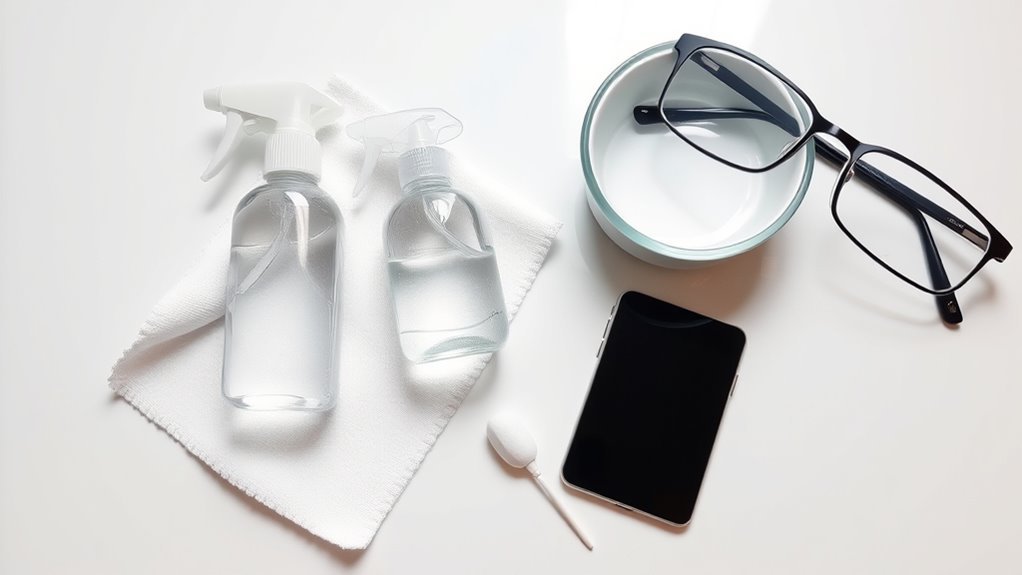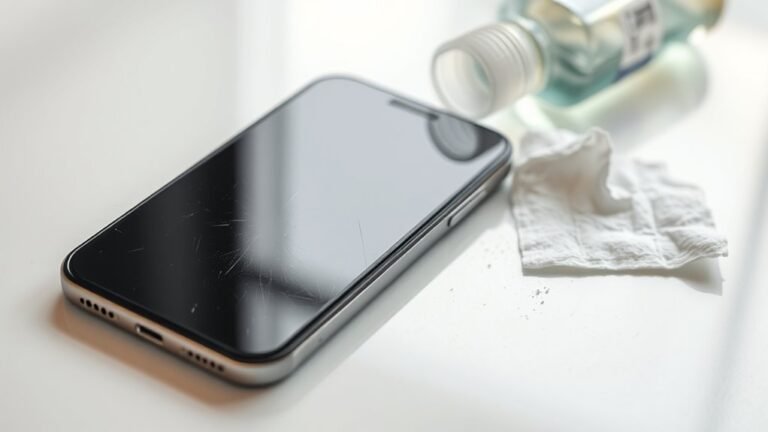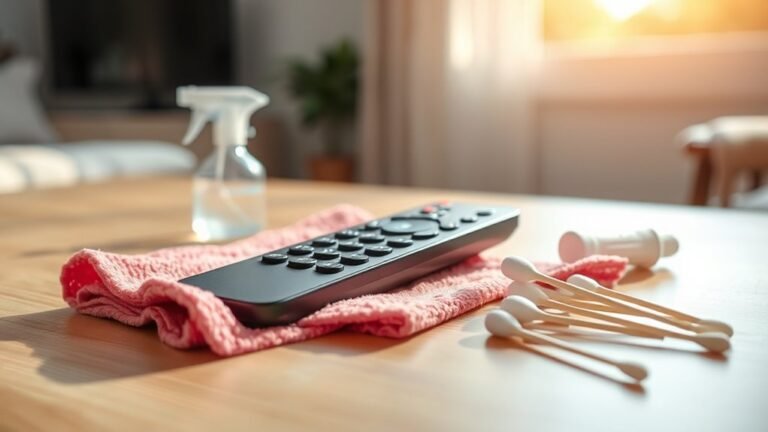Step-By-Step Guide to Cleaning Smartphone
Start by gathering eco-friendly cleaning materials, then power off your phone and remove its case and accessories. Use a microfiber cloth dampened slightly with a safe cleaning solution to wipe surfaces gently. Clean buttons and ports carefully with a soft brush or swab, disinfect with a 70% isopropyl alcohol wipe, and dry thoroughly using a lint-free cloth. Finally, reassemble your device and power it back on. Keep going to discover tips for deeper cleaning and maintenance.
Gather Necessary Cleaning Materials

Before you begin cleaning your smartphone, you’ll need to gather a few essential materials to secure the process is both effective and safe. Opt for eco friendly materials like microfiber cloths, which are gentle on your device and the planet. Avoid abrasive fabrics that might scratch your screen. Choose cleaning solutions that are specifically designed for electronics or make your own with diluted isopropyl alcohol and distilled water—this keeps things natural and free from harsh chemicals. Steer clear of household cleaners containing bleach or ammonia, as they can damage your phone’s coating. Having these materials ready assures you can clean your smartphone thoroughly without risking harm, giving you the freedom to keep your device spotless while caring for the environment.
Power Off Your Smartphone
Before you start cleaning, make sure to power off your smartphone to prevent any accidental taps or damage. To do this, just hold down the power button and follow the on-screen instructions. Turning it off also helps protect your device’s internal components while you clean.
Why Power Off
Although it might seem unnecessary, powering off your smartphone before cleaning it helps prevent accidental damage and guarantees your safety. When your device is off, you avoid unintentional taps or commands that could cause apps to malfunction or data to be lost. It also reduces the risk of short circuits, especially when using liquids or damp cloths during cleaning. Prioritizing smartphone safety assures your device stays in top condition, letting you enjoy the freedom of uninterrupted use. Proper device maintenance starts with simple steps like this, saving you from costly repairs or replacements. So, before you engage in cleaning, remember that powering off is an essential move to protect both you and your smartphone, keeping your tech running smoothly and securely.
How to Power Off
To keep your smartphone safe while cleaning, you’ll want to power it off properly. First, press and hold the power button until the power menu appears. Depending on your model, you might see options like “Power Off,” “Restart,” or “Emergency Mode.” Tap “Power Off” and confirm if prompted. If your device uses smartphone settings for power management, you can also navigate there to shut it down. This simple step is essential for effective device maintenance and prevents accidental inputs or damage. Once off, your smartphone is ready for cleaning without risk. Remember, powering off fully is different from putting your phone in sleep mode, so be sure to shut it down completely for the best care and freedom to clean thoroughly.
Safety Benefits
When you power off your smartphone before cleaning, you reduce the risk of accidental taps or swipes that could interfere with the process or cause unintended actions. This simple step isn’t just about convenience—it’s essential for your safety and device health. Powering down helps avoid short circuits when moisture from cleaning solutions comes into contact with your phone’s sensitive components. Plus, it reinforces the hygiene importance by ensuring you fully focus on sanitizing your device, minimizing germs effectively. Taking this precaution offers clear health benefits, protecting you from bacteria lurking on your screen. By powering off, you claim control over your cleaning routine, ensuring a safer, cleaner phone while enjoying the freedom of a healthier, more hygienic lifestyle.
Remove Case and Accessories
Before you start cleaning, make sure to take off your phone case and any screen protectors. Don’t forget to unplug any charging cables or accessories connected to your device. This helps you access all areas and prevents damage during cleaning.
Detach Phone Case
Start by carefully removing your phone case and any attached accessories. Different phone case materials—like silicone, leather, or hard plastic—require different care, so knowing what yours is made of helps you choose the right cleaning products. Don’t just yank the case off; gently pry it away to avoid bending or cracking it. Once detached, you’re free to clean both the case and your phone thoroughly without risking damage. Use a soft cloth and mild cleaner suited for the case’s material to wipe away dirt and grime. This simple step liberates your device from built-up debris and keeps your phone looking fresh. Detaching the case first sets the stage for a deeper, more effective cleaning process.
Remove Screen Protectors
Carefully peel off your screen protector to guarantee you don’t damage your phone’s display. Different screen protector types, like tempered glass or plastic film, require gentle handling. Use installation tips in reverse—lift gently from a corner, avoid bending, and take your time. Removing your screen protector frees you to clean thoroughly and install a fresh one without trapped dust or bubbles.
| Screen Protector Types | Installation Tips |
|---|---|
| Tempered Glass | Align edges carefully |
| Plastic Film | Avoid touching adhesive |
| Privacy Screen | Clean screen before apply |
| Anti-Glare | Smooth out air bubbles |
| Blue Light Filter | Press firmly for adhesion |
Free your phone’s surface by removing old protectors, then enjoy a crisp, clean screen ready for a new layer.
Unplug Charging Cables
Since you’ve removed the screen protector, unplug any charging cables connected to your phone and take off its case and accessories. This step frees you from any restraints and lets you clean thoroughly without risking damage. Different charging cable types—USB-C, Lightning, or Micro-USB—need gentle handling during removal to avoid wear. Practicing proper cable maintenance not only extends their life but also keeps your device safe.
Remember these tips:
- Gently unplug cables by holding the connector, not the wire.
- Remove all accessories, like pop sockets or mounts, before cleaning.
- Inspect cables for frays or damage to prevent hazards.
Use a Microfiber Cloth for Surface Cleaning
Although you might be tempted to use just any cloth, a microfiber cloth is your best bet for cleaning your smartphone’s surface. Its dense fibers pick up dust, oils, and fingerprints without scratching or leaving lint behind. One key microfiber benefit is its gentle yet effective nature, which protects your screen’s coating and maintains clarity. When using it, gently wipe in circular motions rather than scrubbing hard—this guarantees you remove grime without damaging delicate components. Avoid harsh movements that could cause micro-abrasions. Keeping your microfiber cloth clean is part of these cleaning techniques; wash it regularly without fabric softeners to maintain its efficiency. Embracing microfiber lets you clean confidently and freely, preserving your device’s look and function without hassle.
Apply Cleaning Solution Safely

When you apply a cleaning solution to your smartphone, you’ll want to use just the right amount to avoid moisture seeping into openings. Choosing the right cleaning solution types—like alcohol-based wipes or gentle screen cleaners—can make all the difference. Remember, how you apply it matters just as much.
Here are some application techniques to keep your phone safe and spotless:
- Never spray the solution directly on your device; instead, lightly moisten your microfiber cloth.
- Use gentle, circular motions to clean without scratching or pushing liquid inside the phone.
- Avoid over-saturating the cloth to maintain control over moisture levels.
Following these steps lets you maintain your freedom to use your phone worry-free while keeping it clean and protected.
Clean Around Buttons and Ports
Because buttons and ports are small and recessed, they tend to collect dirt and grime that can affect your phone’s performance. To keep your device running freely, focus on the button crevices and port openings where dust and debris hide. Use a soft-bristled brush or a dry cotton swab to gently dislodge particles without pushing them further inside. Avoid using sharp objects that could damage delicate components. For stubborn grime, slightly dampen the swab with a bit of your cleaning solution, but never pour liquid directly into ports. Taking a few extra moments to clean around these tricky areas guarantees your phone’s buttons stay responsive and ports maintain a solid connection. This simple step liberates your device from buildup, helping it function smoothly and last longer.
Disinfect Your Smartphone Properly

Since your smartphone is one of the most frequently touched items, it can harbor a surprising amount of germs. Prioritizing smartphone hygiene means disinfecting your device properly and regularly. To maintain freedom from harmful bacteria, follow these simple steps:
- Use a 70% isopropyl alcohol wipe or a disinfectant specifically designed for electronics to avoid damage.
- Gently wipe all surfaces, including the screen, back, and sides, focusing on high-touch areas like buttons.
- Avoid harsh chemicals, and never spray liquid directly onto your phone.
Dry Your Device Thoroughly
A few minutes of careful drying can make all the difference in keeping your smartphone safe from moisture damage. After cleaning, use gentle drying techniques like a soft, lint-free cloth to absorb any remaining liquid. Avoid harsh rubbing, as it can scratch your screen or push moisture into tiny crevices. Pay special attention to ports and buttons, where moisture tends to linger. You can also use compressed air to blow out any trapped droplets, but keep the pressure low to prevent damage. Proper drying isn’t just about appearance—it’s essential for moisture prevention and maintaining your device’s freedom to perform without hiccups. By thoroughly drying your smartphone, you’re ensuring it stays safe, functional, and ready to use whenever you need it.
Reassemble and Power On Your Smartphone
Once your smartphone is completely dry, you can begin putting it back together. Take your time to carefully reassemble components to avoid any damage or misalignment. Here’s how to proceed smoothly:
- Align each part exactly as it was before disassembly.
- Secure screws or clips gently to guarantee everything stays in place.
- Double-check that no parts are loose or out of order.
After reassembling all components, it’s time to power on your device. Press and hold the power button to see if it boots up normally. If it does, you’ve successfully completed a thorough cleaning and reassembly. Enjoy the freedom of a clean, fully functional smartphone, ready to accompany you wherever you go!
Frequently Asked Questions
How Often Should I Clean My Smartphone?
You should clean your smartphone regularly to keep germs at bay and maintain its performance. Incorporate it into your daily habits, like wiping down your screen with a microfiber cloth each night. Setting a cleaning schedule, such as a deeper clean once a week using proper solutions, helps you stay on track without feeling restricted. This way, you enjoy the freedom of a fresh device without hassle or worry about buildup.
Can I Use Alcohol-Based Wipes on All Phone Screens?
You can use alcohol wipes on many phone screens, but not all screen materials handle them well. Some screens, especially those with special coatings like oleophobic layers, might get damaged or lose their protective finish if you use alcohol wipes too often. To keep your freedom to clean without worry, check your phone’s manufacturer guidelines first. That way, you’re safe cleaning without risking your screen’s look or functionality.
What Are the Best Cleaning Solutions for Water-Resistant Phones?
You want freedom to clean your water-resistant phone without fear, yet harsh chemicals can damage your device’s screen protection. The best cleaning agents are gentle: a mix of 70% isopropyl alcohol and distilled water works well, or specialized screen-safe wipes designed for electronics. Avoid bleach or abrasive cleaners—they might break that water-resistant seal you rely on. By choosing the right solutions, you keep your phone fresh and fully functional, giving you freedom to use it anywhere.
Is It Safe to Clean My Phone With UV Light?
You might wonder if cleaning your phone with UV light is safe. UV effectiveness in killing germs is proven, but UV safety is a concern since prolonged exposure can damage your phone’s screen or internal parts. If you want freedom from harmful bacteria, using a UV sanitizer designed for phones is a smart choice—it balances germ-killing power without risking your device. Just avoid DIY UV exposure to keep your phone safe and clean.
How Can I Prevent My Phone From Getting Dirty Quickly?
Think of your phone as a treasure chest—keeping it pristine means protecting your freedom to explore without limits. To prevent dirt from setting up camp, embrace daily habits like wiping your screen gently and washing your hands often. Using screen protectors benefits you by shielding against smudges and scratches, acting like a trusty armor. These simple steps help your phone stay clean longer, so you can roam free without constant cleaning interruptions.





